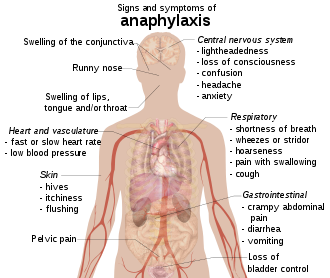Anaphylaxis is a severe, potentially life-threatening allergic reaction that requires immediate medical attention. Here’s an overview of anaphylaxis, including prevention, symptoms, and treatment:
Causes:
Anaphylaxis is triggered by an immune system overreaction to an allergen. Common triggers include:
- Foods: Peanuts, tree nuts, shellfish, fish, milk, eggs, wheat, and soy are common food allergens.
- Insect Stings: Bee stings, wasp stings, hornet stings, and fire ant bites.
- Medications: Antibiotics (particularly penicillin), nonsteroidal anti-inflammatory drugs (NSAIDs), and certain intravenous (IV) drugs.
- Latex: Found in gloves, balloons, and medical devices.
- Exercise: In rare cases, physical activity can trigger anaphylaxis, especially when combined with specific foods or medications.
Symptoms:
Anaphylaxis symptoms typically develop rapidly, often within minutes of exposure to an allergen. They can vary in severity but may include:
- Skin Reactions: Itching, hives, redness, and swelling.
- Respiratory Symptoms: Shortness of breath, wheezing, chest tightness, coughing, or difficulty swallowing.
- Cardiovascular Symptoms: Rapid or weak pulse, drop in blood pressure, dizziness, lightheadedness, or loss of consciousness.
- Gastrointestinal Symptoms: Nausea, vomiting, abdominal pain, or diarrhea.
Prevention:
- Identify Triggers: Knowing what triggers your allergic reactions is crucial for prevention. Common triggers include certain foods (e.g., peanuts, shellfish), insect stings, medications (e.g., penicillin), and latex.
- Avoidance: Once triggers are identified, avoiding them is essential. This may involve reading food labels carefully, informing restaurants about food allergies, wearing protective clothing in environments where insect stings are a risk, and communicating allergies to healthcare providers before medical procedures.
- Medication: Some individuals with severe allergies carry an epinephrine auto-injector (e.g., EpiPen) prescribed by their doctor. This is used for emergency self-administration in case of anaphylaxis.
- Allergy Testing: Consult with an allergist for testing if you suspect allergies but are unsure of the triggers. Identifying specific allergens can guide avoidance strategies.

































